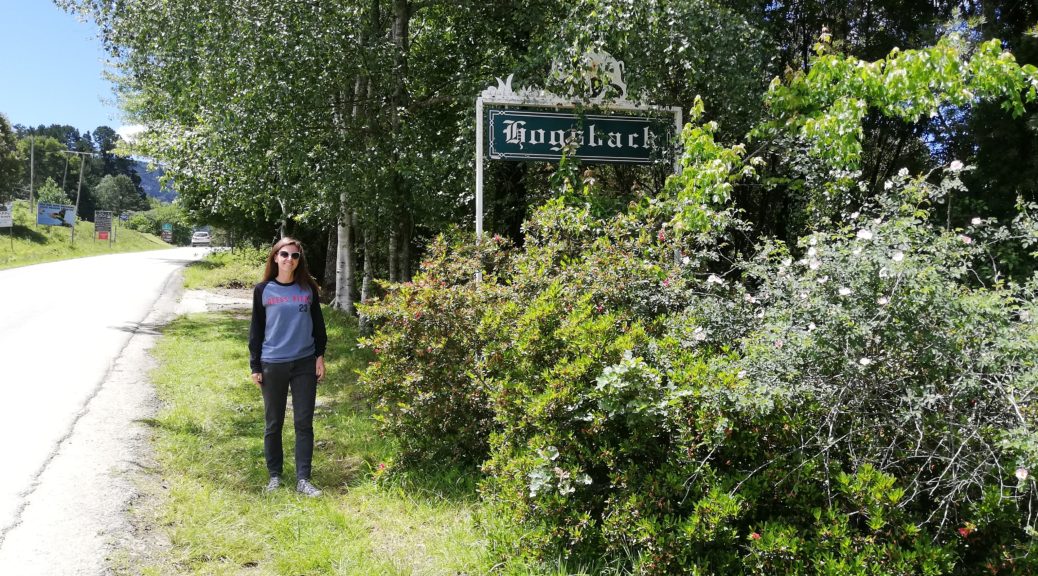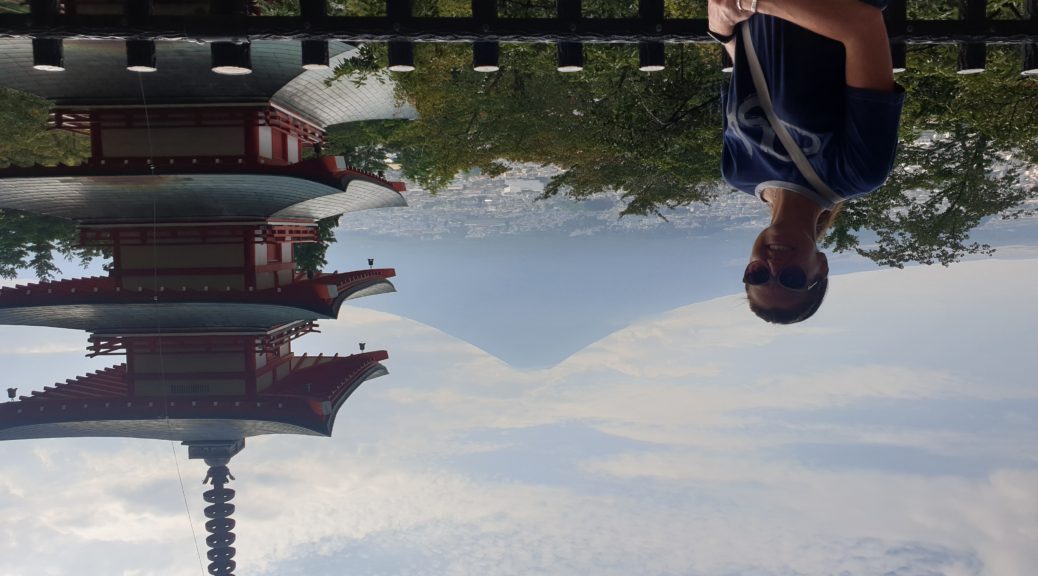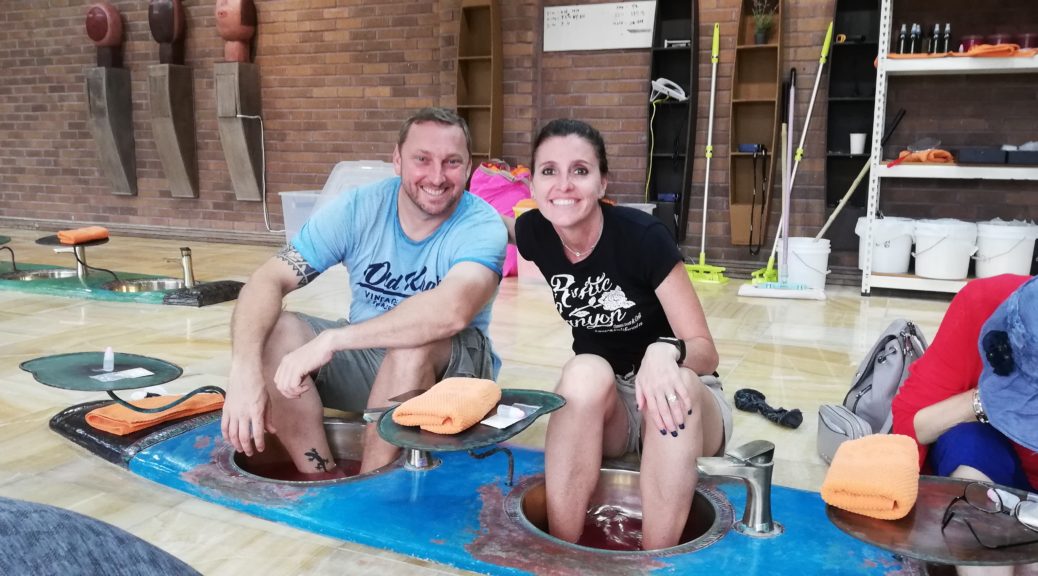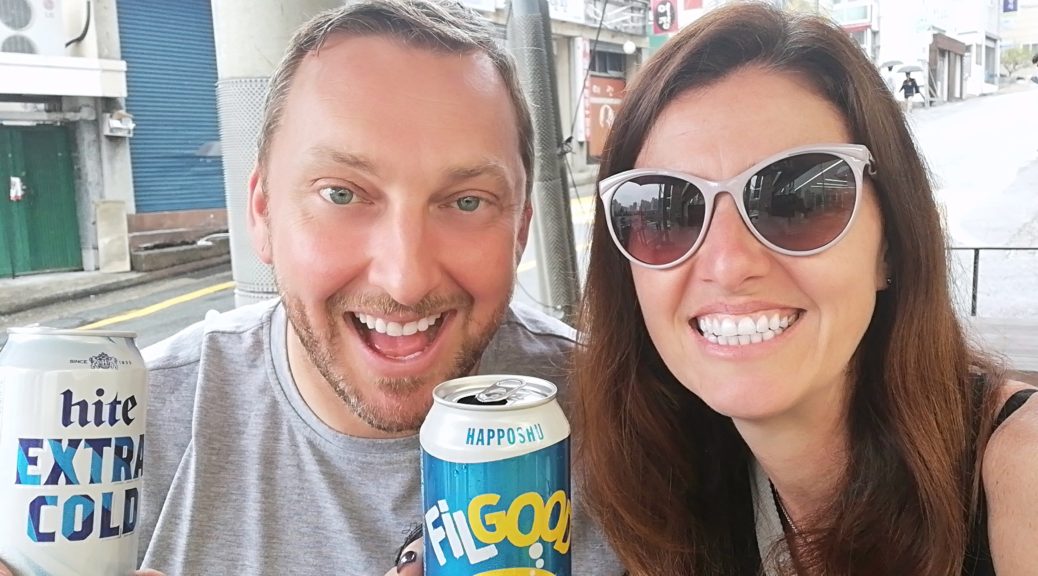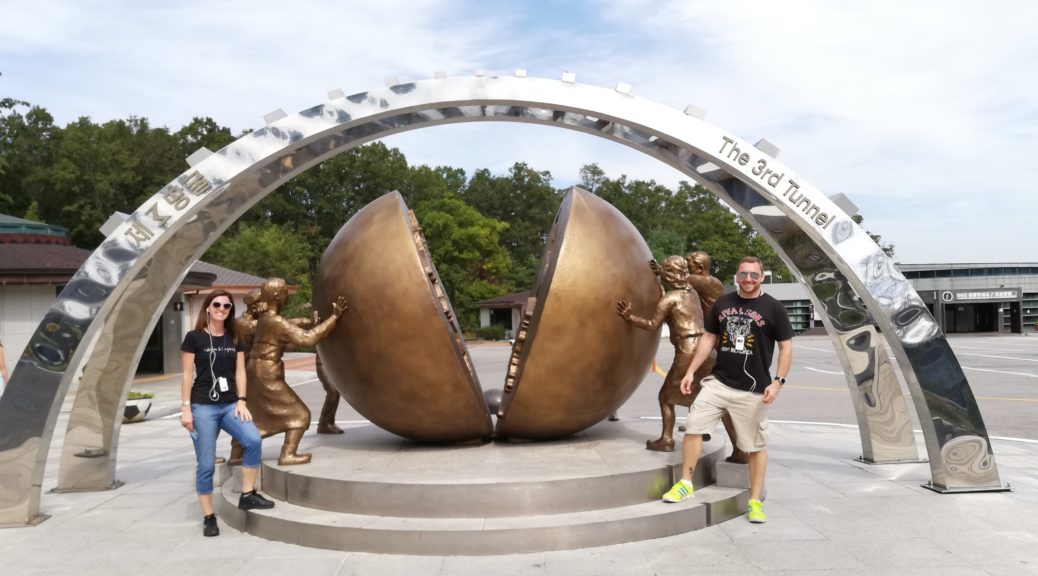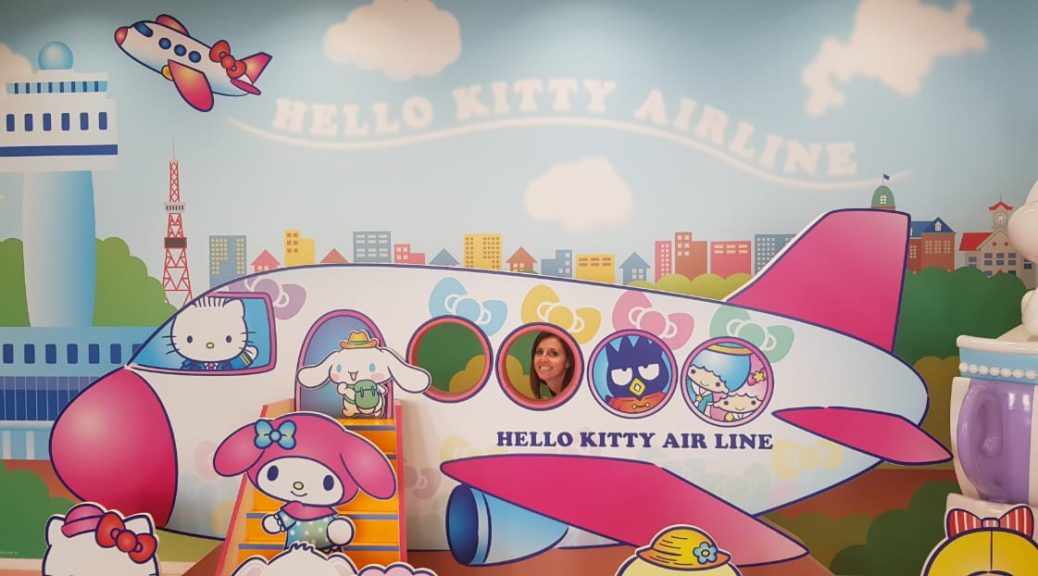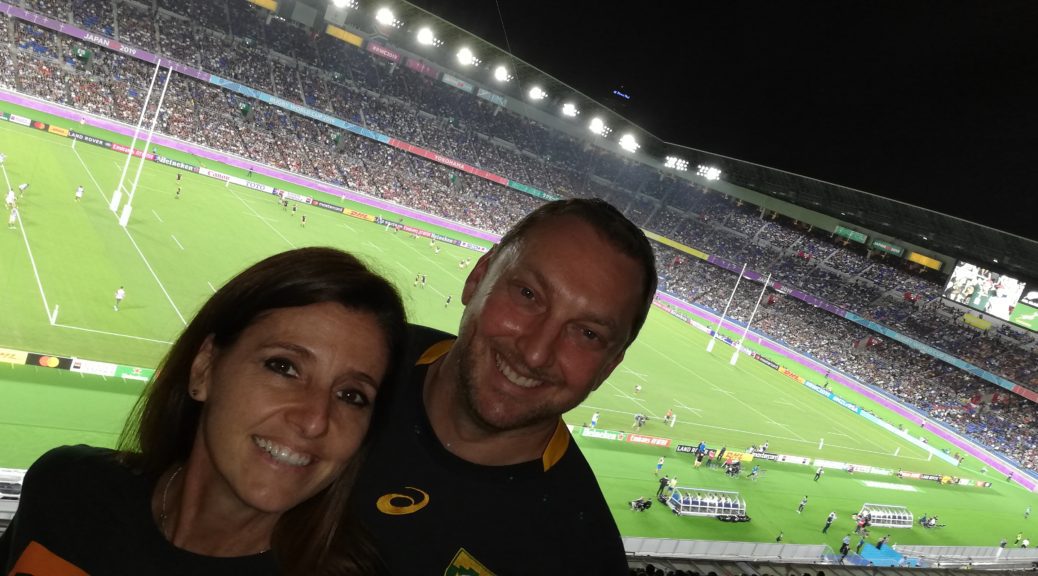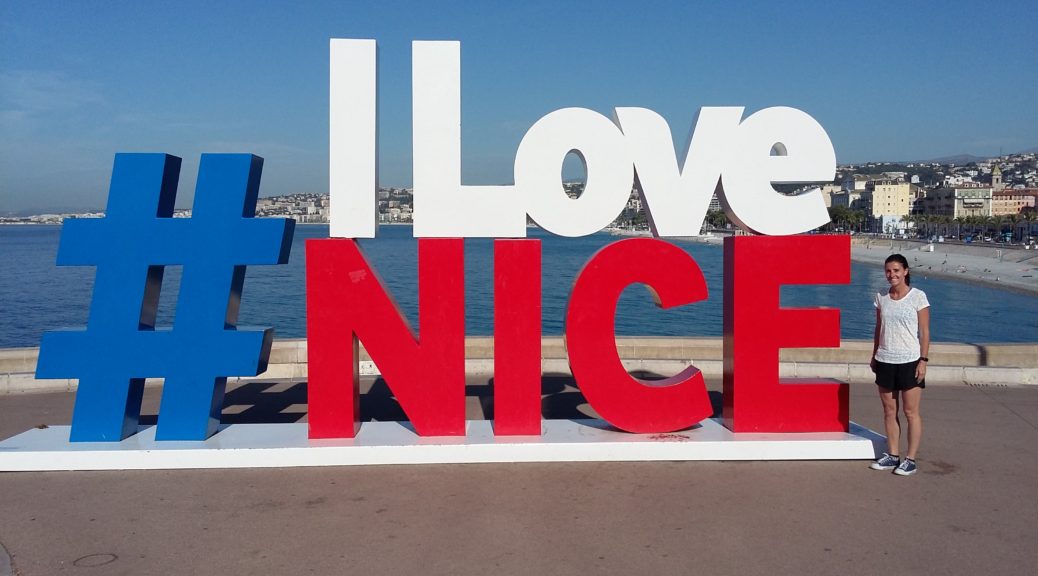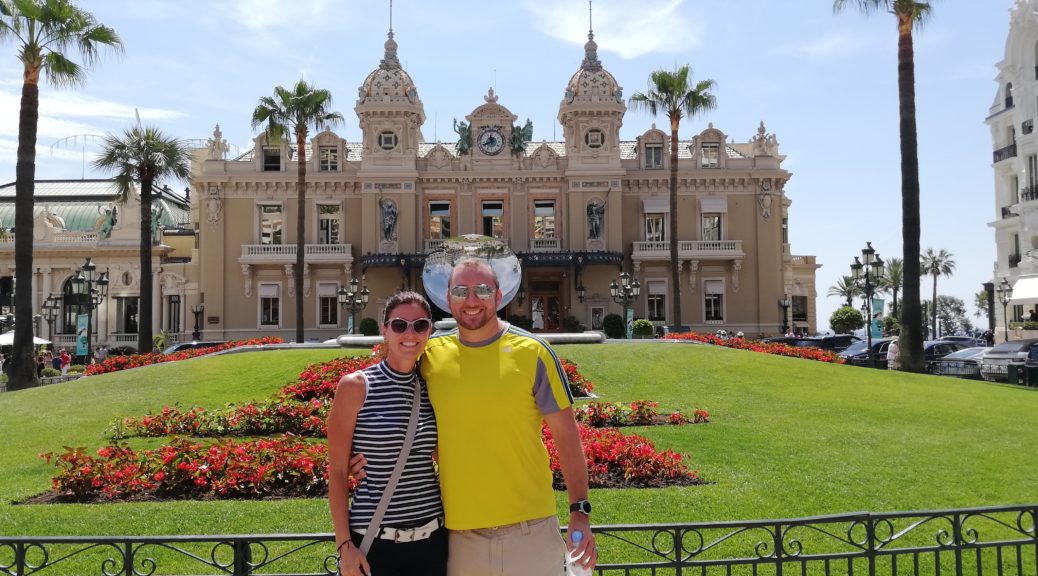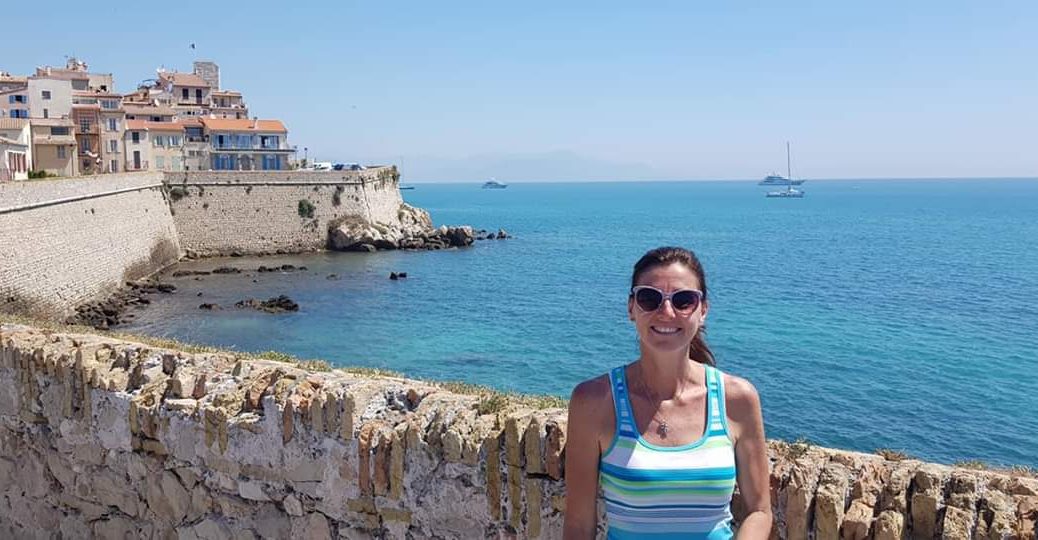SEOUL
24-27 September 2019
While we were in the neighbourhood (relatively speaking, having been in Japan), we thought we’d take the opportunity to hop over to visit South Korea.
We had booked the flight from Sapporo to Seoul several months before so were dismayed when we got an email notification a couple of weeks before travel that the flight was cancelled. It worked out for the best though because we found another flight on another airline at around the same sort of timing – and for half the price!
Once on the plane we surmised the cancellation was owing to not meeting minimum numbers because our new flight was not even half full. Their loss; we had a very comfortable 3 hour flight with our new hosts on Jin Airlines.
It was very exciting approaching Seoul with an aerial view. It was awesome for most cities to come to life after the amount of 2 dimensional planning we put into our trips, but Seoul looked especially surreal from the air with its massive bodies of water and long snaking causeways carrying the tiny little cars inching across them. Or maybe that was just the airport; it remained to be seen.
From our pre-trip research, we knew that public transport would easily get us to our hotel, the Holiday Inn Hongdae, which we’d booked expressly for its location directly above the train station on the line that ran straight from the airport without requiring any connections.
Although the Info desk did a hard sell on the M-Pass, an all-inclusive travel card exclusively for tourists, some quick mental maths decided for us that doing single tickets as we went would be a more economical option.
With no such thing as ticket offices, we were on our own with the self-help ticket machines. Fortunately, there were instruction in English and our destination was easy to spot so we were soon on our way into Seoul.
The hotel was as easy to find as it had promised online, but the ‘no view’ description of the standard room we’d booked wasn’t quite as accurate. Turned out that we did have a view… Of the elevator lobby on our floor! We had a (spacious and gorgeous) interior room with a window facing across the atrium and onto the lifts and passage so not only did we have a view, but so did the other people of the 16th floor have a view of us! Or they would have had, had we chosen to keep the blinds and curtains open.
We had pre-booked a 2 day tour, not wanting to risk missing anything on our short hop through such a massive city. The first day was to be a City Tour and the second a trip to the Demilitarised Zone (DMZ) separating North and South Korea. With our tour guide doing the heavy-lifting, there was no pressure on us to do anything of consequence on our first night so we decided to explore home base.
Since we were in the heart of the Hongdik University area, there was lots to do and flocks of students already out and about doing it.
Across from our hotel was a pedestrian street lined with bars and restaurants shouting out who knows what from busy lightboxes covered in Korean hieroglyphs. Through the middle ran a long strip of park, where countless young people were gathered in little groups sharing a pizza, a picnic or a laugh. A very relaxed atmosphere; chilling and enjoying the evening.
We were hungry and ready for dinner, but deciding between all the options was quite overwhelming. On the one hand we’d intended not to fall back on western / chain food. On the other, having no idea what the Korean writing meant, it was near impossible to figure out what the traditional stuff was that was on offer or how much anything costed.
We ended up doing a full circuit to the end of the pedestrian area and back before settling on a place almost across the road from our hotel, with our choice based purely on what we (thought we) could decode from the bright pictures on the lightbox outside.
We had dakgalbi; a spicy chicken stir fry mixed with cabbage, carrots and thick fingers of udon noodles and served at the table in a skillet which is placed on the element fixed on the table top. A thick vein of grated cheese ran through the middle of the stir fry and to be stirred in as it melts in order to blend as you eat. Stringy mozzarella is no mean feat with chopsticks, I can tell you! We ordered Level 2 of 4 on the spicy scale and it was HOT. Definitely not for sissies!
Very pleased with ourselves for sticking to our traditional guns, we did an after dinner walk around the other side of our hood, which looked a lot sleazier, with more neon and what looked suspiciously like strip clubs. It wasn’t entirely a surprise since this neighbourhood had a reputation for clubbing and, clearly, other nocturnal activities.
We weren’t getting sucked in though since we had an early start, with our guide picking us up from our hotel at 08h15 the following morning.
Early start or no early start, we were determined to make time for a hearty breakfast at the hotel. We were expecting a continental and local combination but were surprised and delighted to find bacon, eggs and sausages, over and above the predictable local fare.
With full bellies, we met with our tour guide, Stella, who took us to our bus. We were the second of five stops to gather our group for the tour; the usual motley collection of Brits, Aussies, an American and us.
Our induction to the tour was Jogyesa Temple built during the Joseon dynasty in 1395 and refurbished in 1910. Stella told us a bit about it, most of which we missed acclimating to her accent but the gist seemed to be about praying to a specific one of the three massive golden Buddha’s depending on what you were asking for. She also told us that with big movement to Christianity and bigger movement to atheism, Buddhism in general was shrinking in South Korea.
From there we needed to zoot over to the Gyeongbokgung Palace (“the palace greatly blessed by heaven”), which was completed in 1395, but deconstructed and rebuilt several times after Japanese invasions. Being the first royal palace built in the Joseon Dynasty, it was where their 500 year history began and was the grandest of the 5 remaining palaces in Seoul.
The rush for us to get there was to view the changing of the guards, which was a spirited affair with a large band procession leading and timing a procession of guards wielding flags and weapons. All dressed in brightly coloured tunics, they certainly presented a very different representation of authority than their camo-clad modern counterparts.
Following the formal proceedings, Stella lead us through the palace gates towards the Royal residence and only when she started her narration did she realise we were short a group member. We’d lost Sanjeev. Among hordes of people. After being told that we had to stick together because it was so easy to get separated.
Stella flapped around panicking and rattling rapidfire Korean into her phone to who knows whom while the rest of us swapped stories, took photos and DID NOT MOVE, as we’d been emphatically instructed by Stella several times.
Sanjeev found us again quite by chance, was quite sheepish at having caused the fuss and we were without a further word about it and living the Dynasty life of concubines and heirs and quirks that come along with the lifestyles of the rich and famous.
The next excursion caught us quite by surprise since it wasn’t listed on the tour we’d booked. We were taken to a Hanbok store and dressed up in traditional outfits. I got a rather fetching poofy white satin number with big bright purple flowers and Christian chose for himself, quite by accident, a King’s outfit with regal blue jacket with silver embroidery.
Once dressed, we were turned past hair and accessories for clips and costume shoes before being presented to the photographer for couples and groups shots. Not something we would have opted to do, but made for some fun memorable pics and we had a laugh with our tour mates.
… which made for better company and more conversation at the group lunch where we enjoyed traditional Korean Barbecue, beers and Soju.
Back in civvies, we were taken to Bukchon Hanok Village; one of the last bastions of traditional Hanok houses from the Joseon period. Retaining the old city appearance and being in such short supply, the houses sell for millions of Dollars, even though the residents are not allowed to alter the appearance of their houses and often have to park their fancy cars outside the suburb and walk to their house.
The tour ended off a climb (in the bus) up the hill so we could get a spectacular panoramic view of Seoul. It was indescribably massive. On the one side was sprawling suburban living creeping up the side of a mountain; on the other was a sea of skyscrapers as far as the eye could see.
While city blocks seem to be step-repeated, as if a big 3D Lego stamp had made its way across the horizon. We had noticed on the ground that the skyscraper buildings were clustered, to the point that a collection of identical buildings would have massive numbers painted on the side so you could tell them apart. Presumably this was what happened when a country (re)built itself with the astonishing efficiency that South Korea had.
The bus had to drop some of our our mates in Myeong Dong; a famous shopping and street food area, so Stella gave us a half hour to explore before resuming the drop-off circuit. So so so many stores selling make up and cosmetics; quite overwhelming with all the special offers and sampling… But a Mecca if that was what you were after!
We were exhausted when we got back to hotel; so much so that I dropped off into a little nap before heading out again.
Our intended mission for the evening had been to find us an Irish pub to log on the Guinness Index, but Google Maps was playing up and not showing walking routes, wanting us to catch a complicated combination of trains to get just down the road (!), so we were unable to find the first one we pegged and gave up on the plan in favour of a dinner on the main drag in Hongdae instead.
THURSDAY
On Thursday morning, Miss June, as she introduced herself, met us at our hotel promptly at 10h00, as planned. We joined the bus with its existing 8 other passengers and Christian was immediately barnacled by a surveyor from London who – as Christian expressed to me in Afrikaans – he was afraid would never stop talking or asking arbitrary questions.
Fortunately Miss June (eventually) clamped on her headset and started the narration for the tour, much to Surveyor’s disappointment.
Miss June told us that Korea was liberated from 35 years of Japanese occupation in 1945 at the end of the Second World War when the Russians came down from the North and the Americans came up from the South, slicing the country in half at the 38th parallel.
Before WWII Korea was a unified country and all the factories and plants were in the North, so when the country split all the infrastructure was in the North and they had a better economy than the South, which had been rural and farming land.
The Korean War then broke out in 1950 with the North invading the South; with Western support the war was brought to a close in 3 years, but at a massive price. From the Korean war 70% of the South’s capital, Seoul, was destroyed as was so much of Pyeoungyang that the Americans said there was nothing left to bomb.
Miss June told us that there was no physical border between North and South, but a 2 km limit line is observed on either side of an imaginary line and NOBODY moves in that No Man’s Land.
We also learned that all the water we could see from the air was the Han River, which was visible from more or less anywhere in Seoul – and was protected by barbed, electric fences and armed guard towers because it flowed down from North Korea so needed to be defended against any spies coming from the neighbour. Defection is less of a concern with only 30 thousand people having successfully defected, mostly to the China side because the South Korean border is so heavily armed.
In places you can see North Korea from the bus, beyond the defences and across the river. The other side is noticeably browner and less vegetated which our guide told us was because only 15% of North Koreans had electricity and were forced to cut down trees for warmth and cooking.
There were ghost town villages on the other bank, where the Northern authorities wouldn’t let people live because it was too easy to escape when the river was so shallow in low tide. Understandable especially now that the tables had turned and the North Koreans were starving and malnourished. Or so the South Koreans were told.
Conversely, our guide shared a heartwarming story about how her parents’ generation sacrificed so her generation could be educated and rebuild their country. Her mom even wore the same single pair of shoes for over ten years to save to pay for their schooling. Now her generation is spending considerable energy instilling in the younger generation why unifying Korea would be a great thing since the younger people don’t feel the loss of relatives and friends trapped across the border and have all the creature comforts that their successful society provides.
By now we’d reached our first stop where we alighted to view the Unification Bridge, built over the Imjin River which runs into the Han. Although in perfect working order, the bridge stands unused since nobody is allowed to cross the border. The bullet-ridden train exhibit on our side of the bank bears not-so-subtle inference as to the consequences.
There was a community of around 200 people that lived within the Imjin line on the Southern side, which was technically under the United Nations Command and those people didn’t do conscription (21 months) or pay tax.
The bus took us to Dorsan Station; a fully decked out train station, all ready to go for a train service that would connect South Korea all the way through to the UK… When and if unification would allow for it. Miss June spoke so optimistically about the possibilities that it was hard to tell if it was wishful thinking or if it was something these people believe that they can will to happen.
In the foyer of the station there was a collection of several framed photos of the North and South Korean Presidents meeting, smiling and shaking hands – wives in tow, like it was a social – as if there might be possibility of such connection. But the display seemed so contrived that again it was hard to decide if I was viewing with Western cynicism or if this was a show being put on to string the hopefuls along.
From the station we entered the Demilitarised Zone, our bus climbing slowly up the hill to get us to the Dora observation point.
Using the fixed binoculars, we could see across the border to the abandoned factory complexes and surrounding residential towns, and beyond to the third largest city in North Korea.
The factories had until 2016 been a collaborative project where 700 South Koreans would commute in and out to the factory to work alongside their Northern colleagues, producing all sorts of things. The Northern workers welcomed the income and the Southern manufacturers provided the materials and utilities and gained from the cheap labour. Finished goods were taken back across the border and dispatched from a control centre that now too lies dark and lifeless.
Now that the collaboration has been stopped, the factory complex lay dormant, the feeder villages have been abandoned and the horizon was dark after dusk since the Southerners were no longer providing electricity to the area.
Miss June said that sometimes you could see soldiers moving around, but we saw nothing.
The bus then took us to the 3rd Tunnel, so named since it was one of the 4 tunnels that the South Koreans discovered that the North Koreans had been digging, ostensibly looking for coal (they had even painted the inside of the tunnels black as ruse clues of coal) but practically preparing for an invasion. With all 4 tunnels pointed toward Seoul and each enabling 30,000 armed soldiers to pass through within an hour, it would irrefutably have been a devastating surprise attack.
We caught a little trolley down into the tunnel and were able to walk all the way to the barricade that was established at the limit line.
In times gone by, these barricades had 24 hour armed guards stationed to detect any signs of North Koreans crashing through but fortunately for those poor sods, technology enabled camera surveillance to save the soldiers the immense discomfort of long and boring shifts in the dark and dank dead-end passage.
We ended the tour with a quick stop at the Unification Village, to see how normally the local people go on with their lives, within the limits of the DMZ. Conveniently, their tax free status allows for slightly relaxed rates on supplies, snacks and souvenirs.
On the return journey, Miss June helped us to map out the rest of our evening. First priority was a visit to the old town wall at Dongdaemun and then down to Gangnam which was bloody miles from anything but just had to be done.
The bus dropped us off with some of the other passengers near the palace so we could jump on the subway to get to the city wall.
Now wise to the ways of the subway, it was more a case of finding exact change than navigating the route and we were soon off in the direction of the Dongdaemun Cultural Centre.
At the tourist desk they armed us with a map of the area and a wall passport in case we were ambitious enough to want to walk the whole city wall (a fortress maybe 19km long, built around Seoul at the very beginning of the Joseon Dynasty), gathering collectors stamps at the ancient gates we would pass through.
We did not, and so we made our way to the nearest gate, got our snaps, walked a section of wall up the hill to admire the view… And then retraced our footsteps, ticking the To Do List and moving on to Gangnam.
A collection of connections later we emerged in Gangnam at sunset. And clearly the end of the workday. The station was heaving, the pavements full of dressed to impress people and the road full – of more than its fair share of fancy luxury vehicles.
The neon was soon to own the night and so we threaded our way through the pedestrians to seek sanctum in a traditional Irish pub to wait out the chaos… And earn an eye-watering #2 on our Guinness Index!!
During our sundowner, we researched what traditional meal we were yet to try and ended up making our way back to the main drag for dinner, to have boiled beef bowls of broth at Bonga that were served steaming to us at the table. So hot that they had to be delivered on a trolley. Very dramatic indeed. And delicious.
The streets were still full of life, with most shops still open until 22h00, but we were a good hour away from our lovely Hongdae homebase so worth catching our ride back sooner rather than later.
The subway was still heaving and showing no signs of letting up. Amazing nightlife for an arbitrary Thursday night in September!
